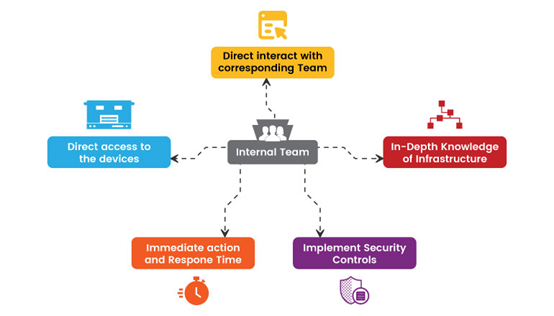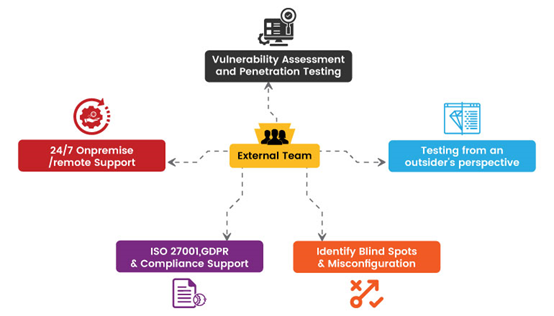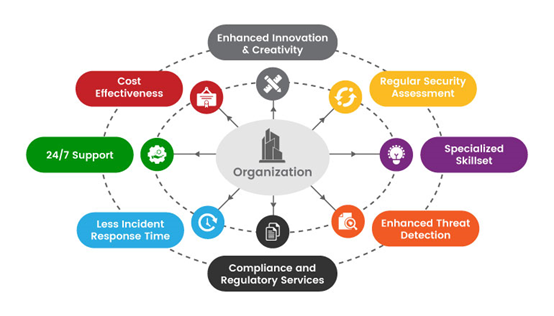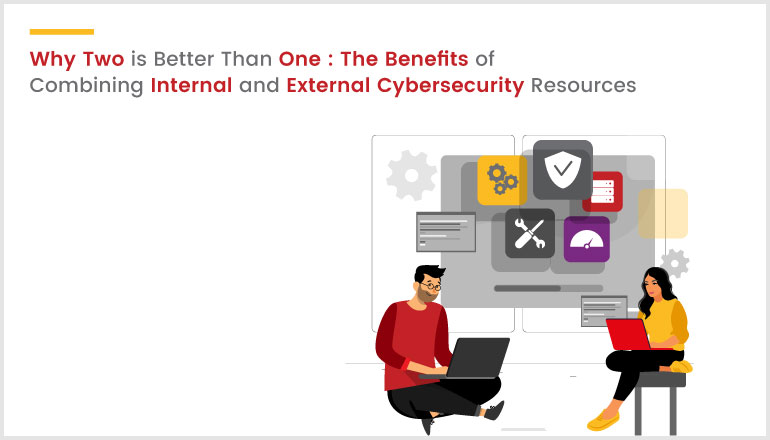Introduction
In today's world, Cybersecurity has expanded quickly and attracted a large audience. Cybersecurity is a crucial aspect of any business, and it involves protecting computer systems, networks, and data from unauthorized access or attacks. Every organization has its own internal cybersecurity team to protect it from cyberattacks.
Despite having internal teams, they must continue to work with external teams for added security. Combining internal and external teams provides additional benefits to an organization.
In this blog, we are going to maximize the benefits of having Internal and External cybersecurity teams.
Who is the internal cybersecurity team?
A team of cybersecurity experts who are directly employed by a company and work exclusively for that organization typically operates within its premises.
The Internal team is mainly focused on protecting its own network, systems, and data, including firewalls, antivirus software, and intrusion detection systems. They also prevent cyber-related attacks such as phishing, ransomware, and data breaches.
Positive Aspects of Maintaining an Internal Cybersecurity Team

- In-depth knowledge: Internal teams bring a deep understanding of the organization's infrastructure.
- Compliance expertise: They possess knowledge about the requirements, compliance, and regulatory frameworks related to data protection and cybersecurity.
- Robust security policies: Internal teams can focus on establishing strong security policies, conducting risk assessments, and implementing preventive measures.
- Collaboration and response: Being part of the organization, they have direct access to the organization's networks, enabling faster response times and collaboration with other departments.
- Accessibility and availability: Internal teams are easily accessible throughout business hours, allowing them to be quickly organized when cybersecurity issues or new threats arise.
- Collaboration with departments: They can closely collaborate with different teams and departments to ensure smooth cybersecurity defenses within the organization.
Who is the External Cybersecurity Team?
A team of cybersecurity experts who are contracted or involved on a temporary basis from outside the company to address particular cybersecurity issues. They are engaged through contracts, which may be project-based, time-limited, or based on specific deliverables.
These external teams can provide additional expertise and support to the internal cybersecurity team, helping to identify and mitigate potential threats before they become a problem.
Benefits of having an External Cybersecurity Team

- Specialized expertise: External teams often specialize in specific areas of cybersecurity, such as penetration testing, incident response, or risk assessment.
- Diverse skills and experiences: They bring a diverse range of skills and experiences from working with various organizations and industries.
- Fresh insights and best practices: External teams can offer fresh insights, identify blind spots, and bring best practices from other environments.
- Scalability: External teams can be scaled up or down according to the organization's needs, providing flexibility in resource allocation.
- Flexibility and project-based engagement: They offer flexibility in terms of resource allocation and can be engaged for specific projects or during peak demand periods.
- Cost-effectiveness: Hiring external teams can be a more cost-effective solution compared to maintaining a fully-staffed internal team, especially for smaller organizations.
- Third-party perspective: External Vulnerability Assessment and Penetration Testing (VAPT) audits are required annually to ensure compliance and provide a third-party perspective on security measures.
Why do Organizations need external Support?
- Internal teams provide continuity and in-depth knowledge, while external teams bring specialized expertise and an external perspective.
- In order to comply with regulations like GDPR, ISO 27001, and PCI DSS, Organizations need to conduct security assessments regularly.
- External teams can be cost-effective as they can be engaged on a contract basis without the need for additional long-term expenses like benefits and training.
- Internal teams are excellent at basic tasks and have domain-specific knowledge, but there are instances when specialized skills are required. External teams fill this gap by providing specialized knowledge and skill sets that internal teams might lack.
- Internal teams bring business culture and personalized solutions, whereas external teams bring new ideas, different viewpoints, and industry exposure, which fuels organizational innovation.

What should you keep internally, and what can you outsource?
- Choosing whether to outsource requires a high-level examination of an organization's risk profile, risk tolerance, and current and future capacity to fulfill its cybersecurity requirements.
- If an organization recognizes the presence of certain security activities, like assessing internal risks posed by insiders, that are better suited for external expertise, it should consider engaging an MSSP to take charge of those responsibilities.
- Similarly, if an organization's security professionals are dedicated to crucial, high-priority functions and prefer not to deal with certain tasks of lesser importance, it would be advisable for them to outsource those low-priority tasks.
- Most organizations are looking to create hybrids. In hybrid arrangements, in-house security personnel, managers, and senior experts often handle strategic activities, while MSSPs handle lower-level tasks such as monitoring.
Best Practices for outsourcing cybersecurity Teams
- Organizations should establish clear roles, responsibilities, and processes to ensure seamless integration and coordination between both sets of Teams.
- Adopt a targeted strategy for cybersecurity outsourcing by thoroughly assessing security requirements and outsourcing only tasks that the organization is unable, unwilling, or should not handle internally.
- Evaluate potential service providers and select Managed Security Service Providers (MSSPs) who possess the necessary expertise and capabilities to fulfill the company's specific requirements.
- Establish Service Level Agreements (SLAs) that are tailored to the organization's security needs.
- Incorporate flexibility into the agreements, enabling the MSSP to adjust the scale of their services based on the changing demands of the organization.
We, at BriskInfosec, offer both internal and external security services to our customers, and we recommend that you consult with one of our representatives to protect your organization against cybersecurity attacks.
Conclusion
Any company aiming to maintain the trust and security of its customers' data must have both internal and external cybersecurity resources in place. The combination of both teams brings additional benefits and enhances the overall cybersecurity measures of the organization. By leveraging the expertise and strengths of both teams, organizations can establish robust defenses against cyber threats and maintain the integrity of their systems and data. It is imperative to have both internal and external cybersecurity resources to ensure the safety, trust, and security of your company.

